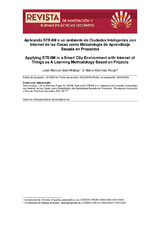Mostrar el registro sencillo del ítem
Aplicando STEAM e un ambiente de Ciudades Inteligentes con Internet de las Cosas como Metodología de Aprendizaje Basada en Proyectos
| dc.contributor.author | Soto Hidalgo, José Manuel | |
| dc.contributor.author | Martínez Rojas, María | |
| dc.date.accessioned | 2019-09-06T10:41:53Z | |
| dc.date.available | 2019-09-06T10:41:53Z | |
| dc.date.issued | 2019 | |
| dc.identifier.issn | 2531-1336 | |
| dc.identifier.uri | http://hdl.handle.net/10396/18979 | |
| dc.description.abstract | Con este artículo se pretenden desarrollar competencias a través de un proyecto práctico donde los estudiantes tendrán que resolver un problema real aplicado a ciudades inteligentes mediante internet de las cosas. Se propone una metodología de aprendizaje basada en proyectos (PBL) donde, a través de un proyecto, los estudiantes crearán y diseñarán su propio prototipo a una solución a un problema planteado, por ejemplo: gestionar automáticamente el alumbrado de una calle o habitación. Los estudiantes tendrán que razonar, analizar dicho reto y crear soluciones innovadoras basadas en STEAM al problema planteado. Los estudiantes diseñarán y construirán un prototipo real y tangible de la solución adoptada utilizando los sensores/actuadores y microcontroladores que ellos consideren. Después integrarán el prototipo diseñado en una pequeña maqueta (construida por los estudiantes como actividad inicial) que simulará una Smart City e interconectarán el prototipo creado con el resto de prototipos haciendo uso de Internet of Things. Finalmente, se realizarán foros de debate, donde participarán todos los estudiantes y moderarán los profesores, sobre las distintas soluciones aportadas con el objetivo de obtener retroalimentación de las propuestas desarrolladas para proponer nuevos retos, encontrar nuevas soluciones a otros problemas o para refinar las anteriores. | es_ES |
| dc.description.abstract | This paper intends to develop competences through a practical project where students will have to solve a real problem applied to smart cities through the internet of things. A project-based learning methodology (PBL) where the students will create and design their own prototype to solve a given problem is proposed, for example: automatically manage the lighting of a street or room. Students will have to reason, analyze this challenge and create innovative solutions based on STEAM to the problem posed. Next, the students will design and build a real and tangible prototype of the solution adopted using the sensors/actuators and microcontrollers that they consider. They will integrate the prototype designed in a small model (built by the students as an initial activity) that simulates a Smart City and interconnect the prototype created with the rest of the prototypes using the Internet of Things. Finally, debate forums will be held, where all the students will participate and the professors will moderate, on the different solutions provided with the aim of obtaining feedback of the proposals. | es_ES |
| dc.format.mimetype | application/pdf | es_ES |
| dc.language.iso | spa | es_ES |
| dc.publisher | UCOPress | es_ES |
| dc.rights | https://creativecommons.org/licenses/by-nc-nd/4.0/ | es_ES |
| dc.source | Revista de innovación y buenas prácticas docentes 8 (2), 68-77 (2019) | es_ES |
| dc.subject | Competencias | es_ES |
| dc.subject | Ciudades inteligentes | es_ES |
| dc.subject | Internet de las Cosas | es_ES |
| dc.subject | PBL | es_ES |
| dc.subject | STEAM | es_ES |
| dc.subject | Competences | es_ES |
| dc.subject | Internet of Things | es_ES |
| dc.subject | Smart cities | es_ES |
| dc.title | Aplicando STEAM e un ambiente de Ciudades Inteligentes con Internet de las Cosas como Metodología de Aprendizaje Basada en Proyectos | es_ES |
| dc.title.alternative | Applying STEAM in a Smart City Environment with Internet of Things as A Learning Methodology Based on Projects | es_ES |
| dc.type | info:eu-repo/semantics/article | es_ES |
| dc.relation.publisherversion | http://www.uco.es/ucopress/ojs/index.php/ripadoc/index | es_ES |
| dc.rights.accessRights | info:eu-repo/semantics/openAccess | es_ES |

